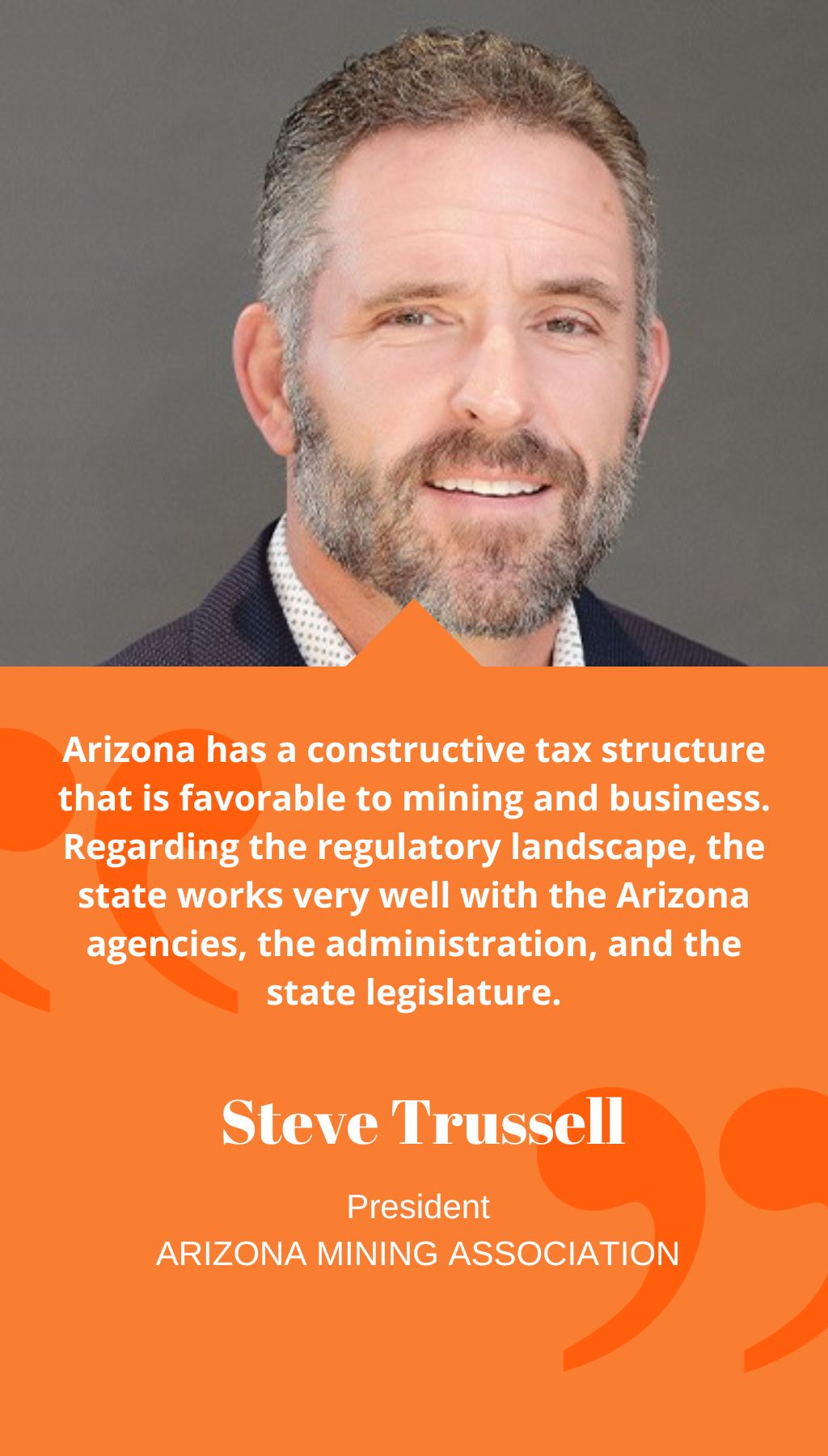
- USA | 15 May 2023

Could you provide an overview of Arizona’s geological potential and the state’s mining industry?
Arizona has a rich history of mining and is well-known as the “Copper State” due to its abundant copper reserves, producing about 74% of the nation’s copper. Arizona is the leading producer of nonfuel minerals in the US and is the second most attractive state for mining investment due to its political and regulatory environment. The state has a tremendous mineral endowment and is starting to see more interest in other elements beyond copper, such as manganese, zinc, lithium, and rare earths.
Can you talk about the permitting issues surrounding Resolution Copper and Rosemont Copper in Arizona?
Recently, both the Resolution Copper and Rosemont Copper projects received favorable decisions from the courts that further define a path forward. The Hudbay Minerals-owned Rosemont project has pivoted towards the Copper World project, which is on private land, rather than trying to mine on federal land and dealing with the permitting issues there. The Copper World project is moving forward very quickly and has incredible reserves. As for Resolution Copper, a world-class deposit over a mile deep, there are cultural concerns over the land they are using, but it is expected that they will find a path forward as many of the issues are being addressed.
What are the main challenges and opportunities in Arizona’s mining sector?
Arizona has a constructive tax structure that is favorable to mining and business. Regarding the regulatory landscape, the state works very well with the Arizona agencies, the administration, and the state legislature, as they understand the importance of mining in the state of Arizona. However, there are many NGOs that have a different opinion about mining, which presents some challenges. In terms of opportunities, the mining industry can hire upwards of 1,000 people for their operations in Arizona, but unfortunately, it is difficult to find people who want to work in an industry they do not understand.
Moreover, the mining industry in Arizona is committed to extracting minerals in a responsible and sustainable way. The state has adopted regulations and policies to mitigate the impacts of mining on the environment, cultural heritage, and public health. The mining companies are also working on innovative solutions to reduce their carbon footprint and improve their social and environmental performance. Arizona’s mining industry is thus a significant contributor to the state’s economy, providing jobs and revenue while ensuring responsible mineral development.
Could you provide an overview of the mining industry in Arizona, specifically in relation to water management?
All mining companies in Arizona have taken initiatives to address ESG-related issues, with water management being a significant topic due to the state’s location in a desert and water supplies being depleted. In 2022, the legislature invested a considerable amount of funds in water augmentation, and an authority was created to address water-related issues in the state. Although the mining industry has been proactive in water management, supporting state efforts to address the challenge remains crucial.
Can you elaborate on the safety standards in Arizona’s mining industry?
According to the Bureau of Labor Statistics, incident rates in mining are lower than that of the retail sector and on par with education. Although Arizona’s incident rate used to be lower than the national average, it has increased slightly above it, which is unacceptable to the mining industry. Our goal is to achieve zero incidents, and we are working to ensure the highest safety standards in the industry.
In your opinion, how do you see the Arizona mining industry evolving in the future?
Considering the global competitiveness for reserves, it is crucial for the US and Arizona to mine domestically. While Arizona is a high-ranking jurisdiction in terms of friendliness to investment and mining, it takes 10 to 12 years to permit mining operations, which is too long. We are exploring new ways to expedite the process of getting mines online, and one approach is to go to older mining sites and examine mining waste, which can present significant opportunities. For instance, the Arizona Sonoran property was previously mined, and an impressive ore body was found under the waste facility. The Arizona Mining Association’s goal is to maintain the US’s competitiveness, and Arizona will remain the number one producer of nonfuel minerals. We aim to provide the quality of life that people enjoy with their electronic devices and electric vehicles while ensuring environmental health and safety in a responsible manner.
Could you speak about the permitting issues around Resolution Copper and Rosemont Copper in Arizona?
Both projects have received favorable decisions from the courts that further define a path forward. Hudbay Minerals, the owner of the Rosemont project, has decided to pivot towards the Copper World project, located on private land, rather than mining on federal land and dealing with the permitting issues there. The Copper World project is advancing quickly and has incredible reserves. In terms of Resolution Copper, which has a world-class deposit over a mile deep, cultural concerns regarding the land they are using have been raised. However, I believe that they will find a way forward, as many of the issues are being addressed.
What are the main challenges and opportunities in Arizona’s mining sector?
Arizona has a tax structure favorable to mining and business, and we work very well with Arizona agencies, the administration, and our state legislature, as they understand the importance of mining in the state. However, several NGO groups have a different opinion about mining, which poses challenges. Mining companies can hire up to 1,000 people for their operations in Arizona, but it is challenging to find individuals willing to work in an industry they do not comprehend. There is a massive mineral endowment in the state, and we are beginning to see increased interest in other elements, such as manganese, zinc, lithium, and rare earths, beyond copper.














